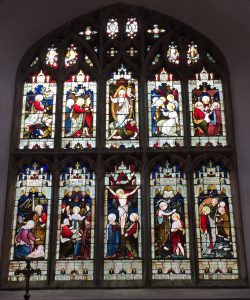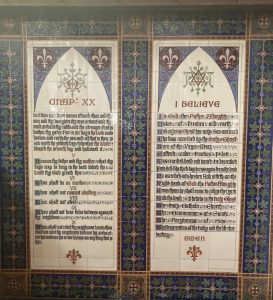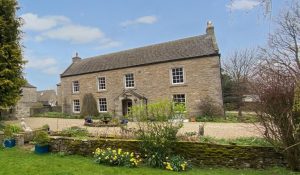East Window
The East Window & Reredos

The magnificent East window was made by Meyer & Co from Munich, Germany and is a fine example of their work. Joseph Gabriel Meyer established an Art Institute in 1847 with studios and workshops in Maxvorstadt, in central Munich. His aim was to produce a variety of different religious artworks from carvings to altars, painted works and stained glass, all of which were inspired by the medieval period. Meyer’s was a family business, with both Joseph’s daughter and son in law, Franz Zettler, involved. Meyer’s glass is easy to recognise; its hallmarks are detailed depictions, using perspective and avoiding heavy intrusive lead work. The studio employed top class artists for the composition and main figures, and they also used rich colour blends, together with all the latest techniques. Our window was designed and manufactured in late 1876 and was installed here in 1877 as a memorial to George Winn, paid for by his friends.
The central panels show the crucifixion and resurrection of Jesus. The other panels show: (bottom L to R) the nativity, Christ in the temple, Jesus’ baptism in the Jordan and Jesus walking on water. (Top) the agony in the Garden, Christ bearing the cross, the women at the tomb and Jesus appearing to the disciples at Emmaus.

Below the window is a tiled reredos. A reredos is a large screen or decoration placed behind the altar which often includes religious images. The tiles making up with reredos were made by The Minton Company of Stoke on Trent, Europe’s leading ceramic factory during the Victorian era. Thomas Minton founded the company in 1793 and it remained in business until it merged with Royal Doulton in 1968. Whilst also making pottery vessels and sculptures, the firm was the leading manufacturer of tiles and other architectural ceramics, and examples of their work are in both the Houses of Parliament in London and the Capitol Building in the United States. The tiles making up the reredos were also a gift from George Winn’s family and the panels show the Lord’s Prayer, the 10 commandments and the Creed. However, the reredos has not been to everyone’s taste. If you look above the reredos you will see a curtain rail, where in the past a curtain hung, so that the reredos could be hidden!
So who was George Winn?
George was the eldest child of George and Elizabeth Winn, who lived at Winnville in Askrigg. George senior had built Winnville in1841 and its distinctive three storey façade still dominates the main street today as the White Rose Hotel. Both George senior and Junior were solicitors, and the Winn family were very prominent in the village and its politics, the church and the wider Dale.
 George was due to marry his fiancée, Emma Clarkson in June 1876. On 23rd April, he had spent the evening with Emma and her family, who lived in The Chantry in West Witton and left to return home at around 11.15pm. The night was dark, and George had the lamps on his dog cart lit. He passed through Aysgarth around 12.30am and from there he would cross the River Ure at Harper Wath, between Aysgarth and Ballowfields, not far from where the footbridge is now. We cannot be certain what happened, but George was found drowned the following morning.
George was due to marry his fiancée, Emma Clarkson in June 1876. On 23rd April, he had spent the evening with Emma and her family, who lived in The Chantry in West Witton and left to return home at around 11.15pm. The night was dark, and George had the lamps on his dog cart lit. He passed through Aysgarth around 12.30am and from there he would cross the River Ure at Harper Wath, between Aysgarth and Ballowfields, not far from where the footbridge is now. We cannot be certain what happened, but George was found drowned the following morning.
A report in the newspaper at the time reported that the ford was ‘an exceedingly good one under ordinary circumstances and the water is very shallow..’ The inquest, held in Carperby, heard that the short stretch from the main road to the ford was very narrow. The left wheel of George’s cart had run up the bank so much that he would naturally have pulled hard on the right rein to bring his horse back onto the track. Because this had occurred so close to the river, instead of following the path of the ford, the cart continued straight and that went into a deep pool. It seems likely that George was either thrown from the cart or jumped out, trying to make for shallower water. The night was so dark, it would have been very difficult for George to know which way to go.
The following morning, John Sarginson’s attention was attracted to movement in the deep pool beside the ford, which turned out to be the horse and cart. A few moments later, John found George’s body some 50 yards further downstream face down in shallow water. His watch had stopped at 12.50am, which was deemed to be close to the time of his death. A verdict of ‘accidental drowning’ was returned by the jury, together with a recommendation to the Highways Board that something should be done to make the ford safer as this had not been the first drowning at the spot.
George had been held in high regard locally. The newspaper report states
‘The universal grief of the inhabitants of Wensleydale shows but in part the great respect which all classes entertained for Mr George Winn and only imperfectly expresses their great grief at his lamentable end. Wensleydale has lost in him an accomplished member of his profession, an honourable and high principled man, a true friend and kind neighbour; such a one is seldom seen, and his place will, indeed, be difficult to fill.’
His fiancée, Emma, never really recovered from George’s death and was subject to depression and dark moods afterwards. During one of these she had her room painted in black as a mark of respect for George. On 9th October1884, the family became concerned when Emma did not appear for breakfast. When they went into her room, they thought she was asleep, but on closer inspection it was realised she was dying. In her bed was a pistol and she had managed to shoot herself in the chest. She was buried in West Witton churchyard in the Clarkson family plot.
